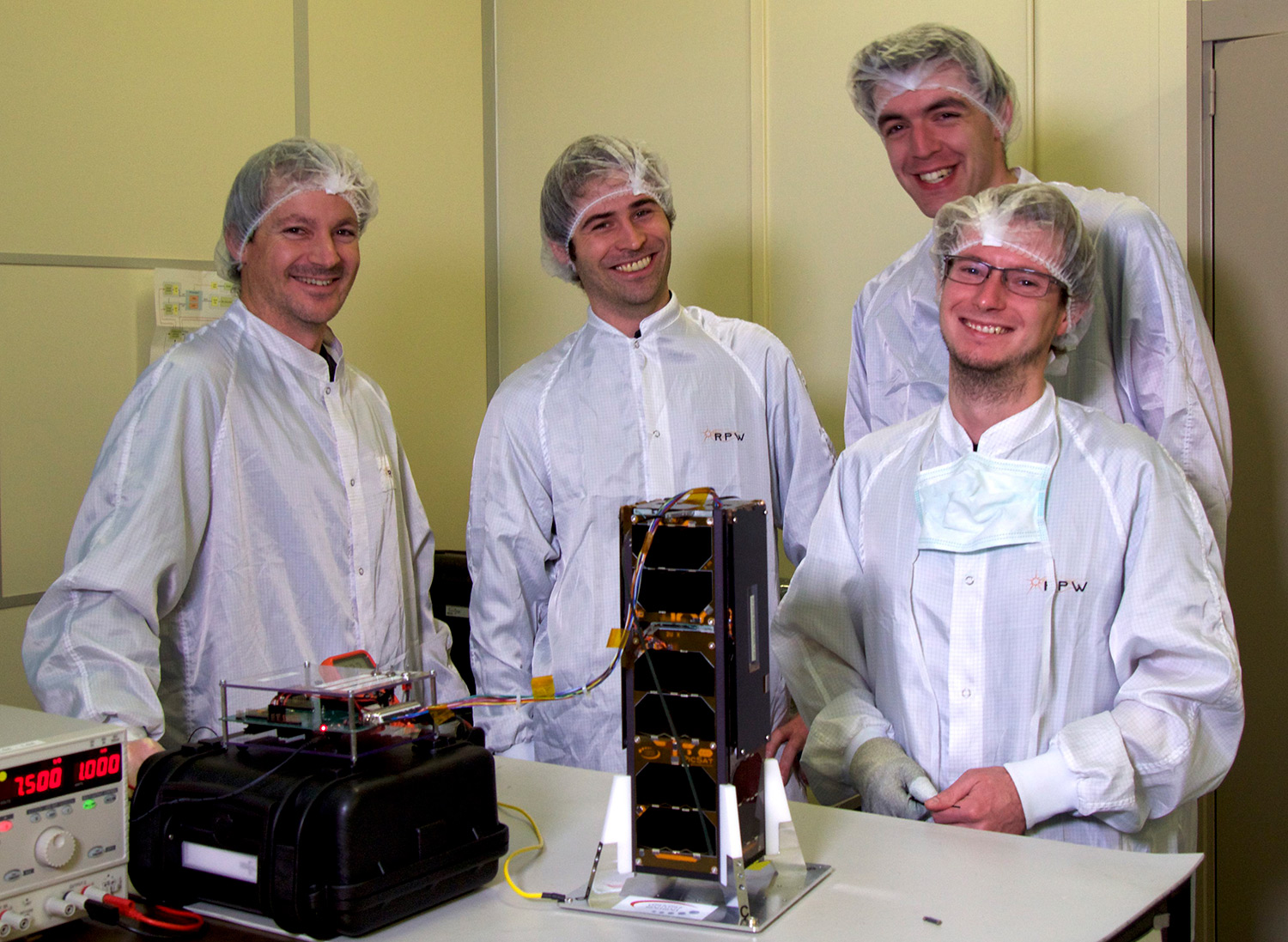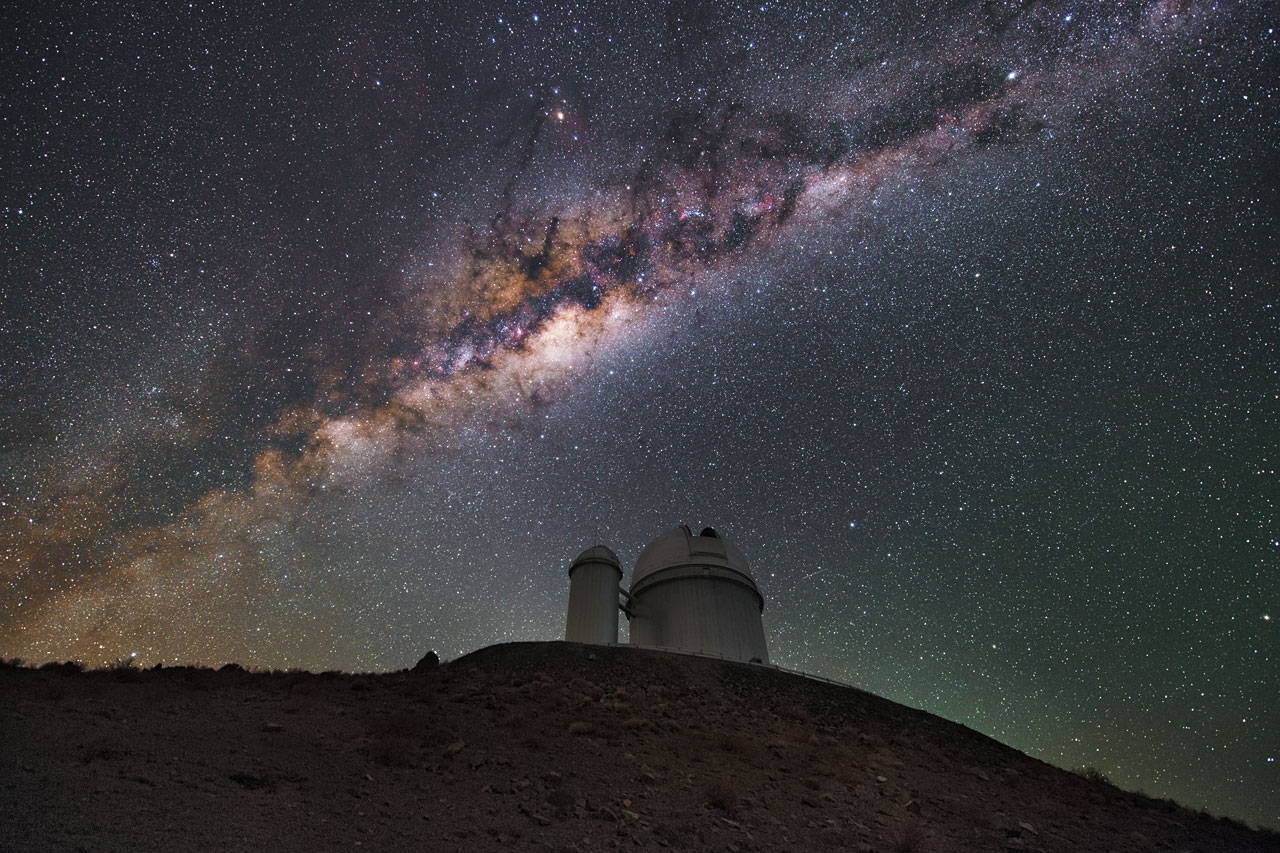
Combining the freedom of a CubeSat with the power of an ESO telescope
How ESO’s HARPS will help PicSat the CubeSat to unravel the mysteries of the Beta Pictoris star system
- PicSat, a CubeSat that hopes to find out more about the Beta Pictoris star system
- Transits of exoplanets around their host stars
- How satellites and ground-based telescopes can work together to discover the Universe
Q. First of all, tell us a bit about why you chose to look at the Beta Pictoris star system.
A. Having celebrated only roughly 23 million years of life, Beta Pictoris is a very young star, astronomically speaking. At about twice the mass and size of the Sun, and just 63.4 light years away, it is relatively easy to observe. Over the past decades, Beta Pictoris has been a popular target for astronomers studying the early stages of star and planet formation, with those astronomers often using ESO facilities. In 2008 a team of French astronomers discovered a giant gas planet orbiting Beta Pictoris. The planet, baptised Beta Pictoris b, has about seven times the mass of Jupiter and orbits its host star at around ten Astronomical Units (AU). The distance between Beta Pictoris and Beta Pictoris b is similar to that between the Sun and our neighbouring ringed planet, Saturn.
A few years ago it became clear that from the viewpoint of the Earth, either Beta Pictoris b, or at least its Hill Sphere, will transit in front of Beta Pictoris. The Hill Sphere of a planet is its gravitational sphere of influence — the region around it that dominates the attraction of rings and moons. Observing a planetary transit would tell us more about the young planet, for example about its size and the chemical composition of its atmosphere. Observing a Hill Sphere transit could tell us about the properties of objects around Beta Pictoris b, for example, its moons or rings.
Q. Sounds exciting! So what exactly happens during a transit?
A. During a transit, the planet blocks the light from a small part of the star, diminishing the amount of starlight that reaches us. A telescope captures the light from the star, and a sensitive instrument called a photometer accurately measures the amount of light received. The main goal of PicSat will be exactly that — to monitor the brightness of Beta Pictoris continuously, so as to capture the little revealing dip in its lightcurve as the planet Beta Pictoris b, or its Hill Sphere, passes in front of it.
A transit of Beta Pictoris b itself would take a few hours and would show a clear dip in the light curve. Because the reach of the Hill Sphere extends a very long way from the planet, a transit of only the Hill Sphere could take up to several months and could result in a more irregular light curve as several rings or moons pass by.
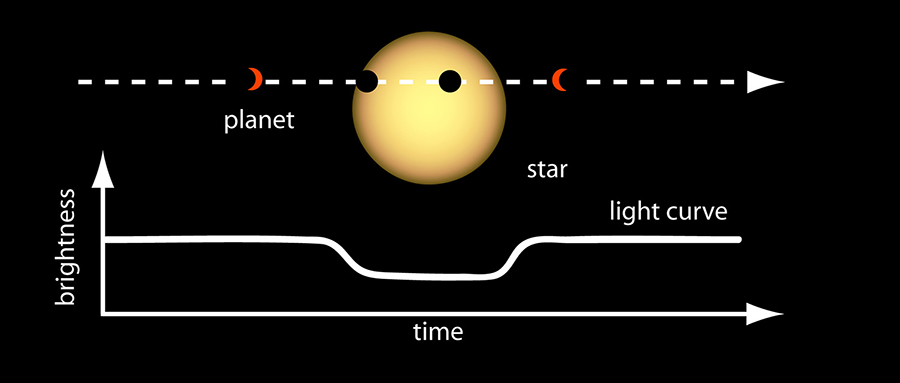
Q. And why did you choose to build PicSat for this job? Couldn’t an existing ground-based telescope do exactly the same thing?
A. So far it has only been possible to estimate an approximate time for the moment of transit — we believe that it should occur by summer 2018. Because of this uncertainty, we needed something that could continuously monitor the star system. Ground-based telescopes can only observe at night and are in high-demand — they are too busy to make continuous observations. So we decided that sending a satellite into space would be the only way to ensure that we capture this phenomenon. PicSat will orbit around the Earth from pole to pole, as the Earth rotates below it. This means that PicSat can always see to either side of the Earth without its view being blocked, allowing it to continuously observe Beta Pictoris.

When PicSat observes photometrically that a transit is taking place, we will use an online form to alert people working at the ESO 3.6-m telescope. As soon as possible after they have been alerted, they will use the HARPS (High Accuracy Radial velocity Planet Searcher) instrument to make detailed spectroscopic observations. The photometric (measurement of the amount of light) and spectroscopic (measurement of the wavelength distribution of light) observations can then be combined to find out much more about the star system.
Q. We’d love to hear a bit more about PicSat itself.
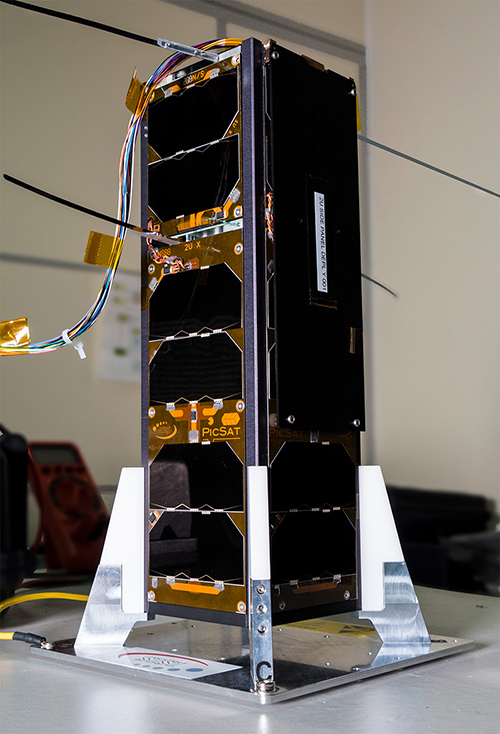
A. PicSat, a contraction of Beta Pictoris and Satellite, is composed of three standard cubic units with side lengths of 10 cm. The project started in 2014 when I proposed using CubeSat technology to observe the predicted transit. I gathered a small local team and together we worked hard to design and build PicSat. It is incredible that in less than four years we have reached a stage where PicSat is being launched!
One really cool thing about PicSat is that it is one of the few CubeSats worldwide with an astrophysical science goal, and is the first CubeSat aiming to provide answers in the challenging field of exoplanetary science.
Q. You say that PicSat is made of three cubic units — do these units each have different roles in the operation of the satellite?
A. Absolutely! The top and middle cubic units house the “science payloads”, whilst the bottom unit contains the onboard computer.
More specifically, the top cubic unit of PicSat contains a small telescope. Thanks to the brightness of Beta Pictoris, the mirror of this telescope can have a diameter of just 5 cm.
This telescope sends the light from Beta Pictoris down into the middle unit. Here, a tiny optical fibre, three micrometres in diameter (or about a fifth of the size of a thin human hair) collects the light and guides it onto a sensitive photodiode that accurately measures the arrival time of each individual photon. Because light will be guided by the tube-shaped fibre, unwanted light will be prevented from entering the photodiode. This allows for a very accurate measurement of the star’s brightness. Imagine looking through a tube — you are able to focus much more easily on a distant object than if you use just your unaided eye because the tube prevents peripheral light from entering your eye. Optical fibres are often used in ground-based telescopes, but this will be the first time an optical fibre is flown in space for astronomical observations.
However, PicSat will wiggle and wobble a little as it orbits the Earth, so the accuracy with which it points at Beta Pictoris wouldn’t be good enough for the telescope to send all the light from the star into the small fibre all the time. We devised an innovative solution to this problem by connecting the optical fibre to a small plate, a “piezoelectric actuator”, that can track the star and immediately follow it to remain on target.
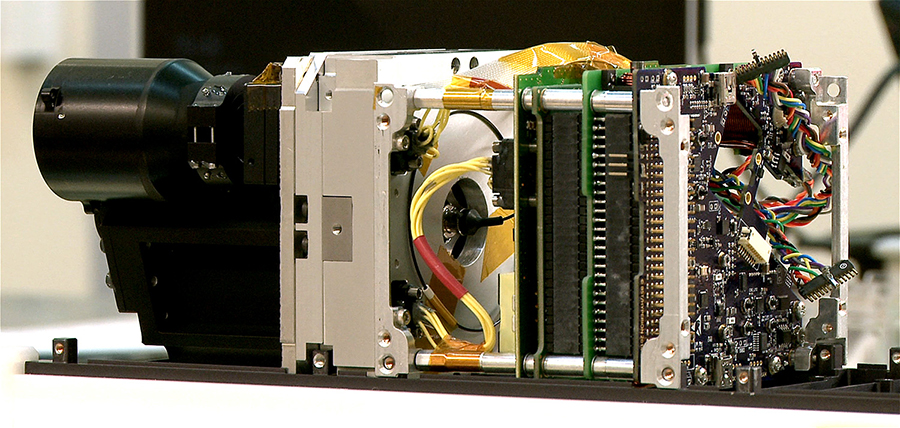
The bottom unit of PicSat contains the onboard computer for operating the satellite, communicating with Earth, raw pointing of the telescope and other important monitoring tasks. The whole satellite is clothed in solar panels that provide the satellite with energy, but it does not need a lot. In fact, the total power consumption of PicSat is about 5 watts, similar to a small light bulb!
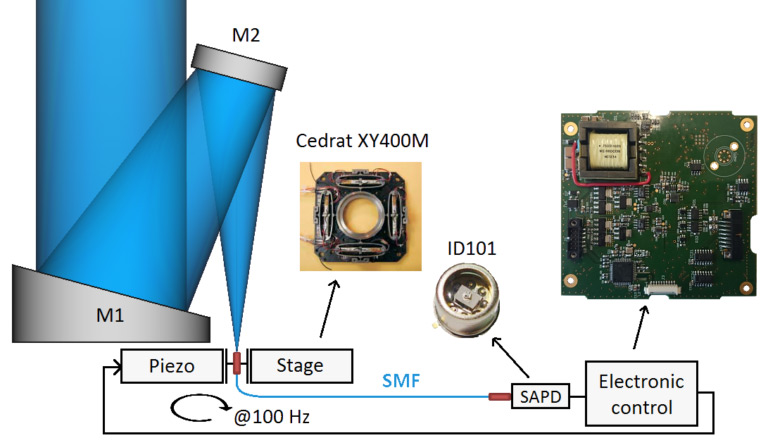
Q. And what exactly will happen when PicSat observes a transit?
A. If PicSat detects the beginning of a transit, whether it be Beta Pictoris b, its Hill Sphere, or any other transit like phenomena, ESO’s 3.6-metre telescope will immediately be put into action. Dr Flavien Kiefer from the Institut d’Astrophysique de Paris will lead the ground-based observations and has guaranteed time using HARPS to support PicSat. He will be the one to respond quickly to our online alert.
Another exciting thing this project might address is that the Beta Pictoris system is rich in objects thought to be comet-like, which have often been observed spectroscopically by ESO telescopes. The presence of these objects has been inferred through the absorption lines of elements such as calcium, sodium and iron present in the object’s tails, which appear in the spectra and disappear again as they transit the star. However, a photometric detection of the dust in a cometary tail passing in front of Beta Pictoris has not yet been achieved. PicSat could well provide us with the first of these observations, which would confirm that these objects are indeed exocomets. If combined with an immediate follow up by HARPS, this would provide new and unique information about such comets and the system as a whole.
Q. And finally, I’m curious to know what could go wrong and how you would deal with any problems that might arise.
A. As with any space mission, things can, of course, go wrong! This is the first time that our team (and in fact the LESIA lab!) has constructed an entire satellite, and with a small team, low budget and short time-scale, risks are higher than for conventional missions.
We were most concerned about the launch, but that was a huge success this morning!! So the next stage is to cross our fingers that the automatic initiation sequence that will start PicSat works successfully. At the end of this sequence, antennas will deploy — critical for communication with the satellite. Antenna deployment and pointing at Beta Pictoris have been tested many times in the lab, so we are hopeful that they work in space as well.
As for how we would deal with it, well that really depends on the problem! Fortunately, we have a varied and intuitive team and we believe can adapt to most situations.
The PicSat satellite was successfully launched at 05:00 CET on Friday 12 January 2018. Follow the progress of the mission and find out more about the project at https://picsat.obspm.fr.
Numbers in this article
| 3 | Number of standard cubic units that make up PicSat |
| 3 | Diameter of PicSat’s optical fibre in micrometres |
| 5 | Diameter of PicSat’s telescope mirror in centimetres |
| 5 | Power of PicSat in watts |
| 10 | Length of one side of a cubic unit in centimetres |
| 63.4 | Distance to Beta Pictoris in light-years |
| 2008 | Year that Beta Pictoris b was discovered |
| 2014 | Year that the PicSat project began |
| 23 000 000 | Age of Beta Pictoris |
Links
Biography Sylvestre Lacour from the PicSat team
PicSat has been developed by a small team at the LESIA laboratory of the Paris Observatory and the Université PSL, that is being led by Dr. Sylvestre Lacour, astrophysicist and instrumentalist at the French CNRS at the LESIA laboratory/Paris Observatory. The PicSat science case was defined in collaboration with Dr. Alain Lecavelier des Etangs, from the Institut d’Astrophysique de Paris, who has been working on the Beta Pictoris system for many years. The PicSat project also results from the fruitful collaboration with CCERES, the space “Center & Campus” of Université PSL, and experts from the French Space Agency, CNES.
PicSat is financially supported by the European Research Council (ERC) under the European Union’s Horizon 2020 research and innovation programme (Lithium proposal 639248), the CNRS, the ESEP Laboratory Group, the Universite PSL, the Fondation MERAC, the CNES, CCERES and the Observatoire de Paris – LESIA.

